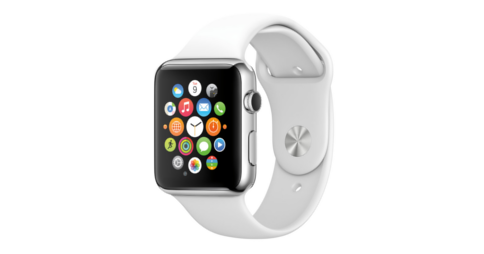
According to Apple’s page about the accessibility of the watch, users can immediately activate the VoiceOver screen reader function and Zoom feature during initial set up. Users need to triple-click the Digital Crown on the device to use VoiceOver or ask Siri—Apple’s intelligent personal assistant—and double-tap with two fingers to Zoom.
Vision
The watch’s vision-related accessibility features, according to Apple:
- Extra-Large watch face: Apple Watch comes with an option for an extra-large watch face with numbers that take up the entire screen making it easier to view the time.
- Font adjustments: When you activate Larger Dynamic Type, text inside a range of apps including Mail, Messages and Settings is converted to a larger size to make it easier to read. You can also choose Bold Text to make the text heavier across all built‑in apps.
- VoiceOver: A gesture-based screen reader that tells you everything that’s happening on the screen and helps you navigate it. VoiceOver on Apple Watch is compatible with built-in apps and is available in all 14 supported languages. You can turn it on via the Apple Watch or the Watch app on iPhone, using the accessibility shortcut, or just ask Siri on the Apple Watch to do it for you.
- Zoom: A built-in magnifier that works wherever you are in Apple Watch. Use the Digital Crown to go across the screen by rows or use two fingers to move around the screen. Magnification of up to 15 times the native size is available.
- Grayscale: If your vision is impaired by colour, Apple Watch lets you enable grayscale onscreen. Once you set the filter, the settings apply system-wide, so you’ll see only shades of gray on the Home screen, apps and more.
- Reduce Motion: Some screen elements—such as the movement of icons on the Home screen— will be simpler and more directly associated with your navigation gestures. Some screen elements will also no longer move.
- Reduce Transparency: For features like alerts, Siri and Glances, you can increase the contrast on your Apple Watch screen by reducing the background transparency.
- On/Off Labels: To make it easier to see whether a setting is on or off, you can have Apple Watch show an additional label on the on/off switch.
Hearing
- Mono Audio: When you’re using Bluetooth headphones, you may miss some audio if you’re Deaf or hard of hearing in one ear. Apple Watch supports Mono Audio, allowing you to play both audio channels in both ears, and letting you adjust the balance for greater volume in either ear.
- Taptic Engine: A linear actuator inside Apple Watch that produces haptic feedback. You’ll feel a gentle tap on your wrist every time a notification comes in. And you can turn on Prominent Haptic to pre-announce some common alerts.
Device accessibility feature comparison
| Accessibility feature | Apple Watch | iPad | iPhone | iPod Touch |
|---|---|---|---|---|
| Voiceover | yes | yes | yes | yes |
| Zoom | yes | yes | yes | yes |
| On/off labels | yes | yes | yes | no |
| Dynamic Type | yes | yes | yes | yes |
| Greyscale | yes | yes | yes | no |
| Bold text | yes | yes | yes | no |
| Mono audio | yes | yes | yes | yes |
| Larger text | no | yes | yes | yes |
| Subtitles and captioning | no | yes | yes | no |
| On-screen keyboard/keyboard | no | yes | yes | yes |
| Invert colours | no | yes | yes | yes |
You might also like:
- More information on on iOS accessibility, covering the iPad & iPhone
- Accessibility features of wearable technology, including other smartwatches and Google Glass
- Information on Android device accessibility features
- Windows phone and tablet accessibility guides
- Everything you need to know about desktop accessibility, in particular Windows and Mac
Top of page

